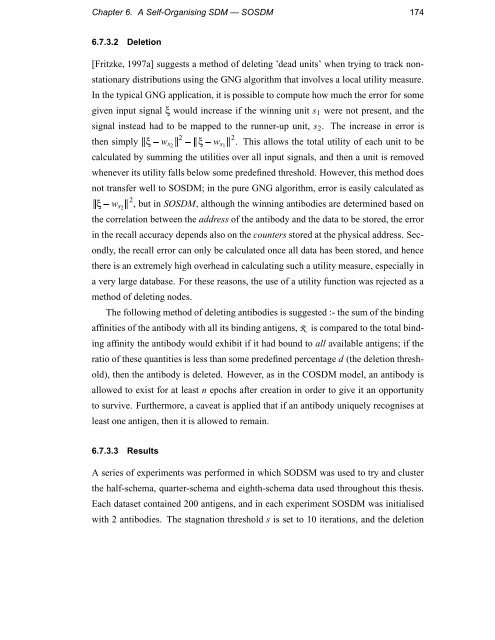Immunology as a Metaphor for Computational ... - Napier University
Immunology as a Metaphor for Computational ... - Napier University
Immunology as a Metaphor for Computational ... - Napier University
Create successful ePaper yourself
Turn your PDF publications into a flip-book with our unique Google optimized e-Paper software.
Chapter 6. A Self-Organising SDM — SOSDM 1746.7.3.2 Deletion[Fritzke, 1997a] suggests a method of deleting ’dead units’ when trying to track nonstationarydistributions using the GNG algorithm that involves a local utility me<strong>as</strong>ure.In the typical GNG application, it is possible to compute how much the error <strong>for</strong> somegiven input signal ξ would incre<strong>as</strong>e if the winning unit s 1 were not present, and thesignal instead had to be mapped to the runner-up unit, s 2 . The incre<strong>as</strong>e in error is2 . This allows the total utility of each unit to bethen2simply ξ w m s2 ξ w m m s1 mcalculated by summing the utilities over all input signals, and then a unit is removedwhenever its utility falls below some predefined threshold. However, this method doesnot transfer well to SOSDM; in the pure GNG algorithm, error is e<strong>as</strong>ily calculated <strong>as</strong>2 , but in SOSDM, although the winning antibodies are determined b<strong>as</strong>ed onξ w m s2 mthe correlation between the address of the antibody and the data to be stored, the errorin the recall accuracy depends also on the counters stored at the physical address. Secondly,the recall error can only be calculated once all data h<strong>as</strong> been stored, and hencethere is an extremely high overhead in calculating such a utility me<strong>as</strong>ure, especially ina very large datab<strong>as</strong>e. For these re<strong>as</strong>ons, the use of a utility function w<strong>as</strong> rejected <strong>as</strong> amethod of deleting nodes.The following method of deleting antibodies is suggested :- the sum of the bindingaffinities of the antibody with all its binding antigens, R is compared to the total bindingaffinity the antibody would exhibit if it had bound to all available antigens; if theratio of these quantities is less than some predefined percentage d (the deletion threshold),then the antibody is deleted. However, <strong>as</strong> in the COSDM model, an antibody isallowed to exist <strong>for</strong> at le<strong>as</strong>t n epochs after creation in order to give it an opportunityto survive. Furthermore, a caveat is applied that if an antibody uniquely recognises atle<strong>as</strong>t one antigen, then it is allowed to remain.6.7.3.3 ResultsA series of experiments w<strong>as</strong> per<strong>for</strong>med in which SODSM w<strong>as</strong> used to try and clusterthe half-schema, quarter-schema and eighth-schema data used throughout this thesis.Each dat<strong>as</strong>et contained 200 antigens, and in each experiment SOSDM w<strong>as</strong> initialisedwith 2 antibodies. The stagnation threshold s is set to 10 iterations, and the deletion









![Unit 5. Switches and VLANs [PDF]](https://img.yumpu.com/34422504/1/184x260/unit-5-switches-and-vlans-pdf.jpg?quality=85)






